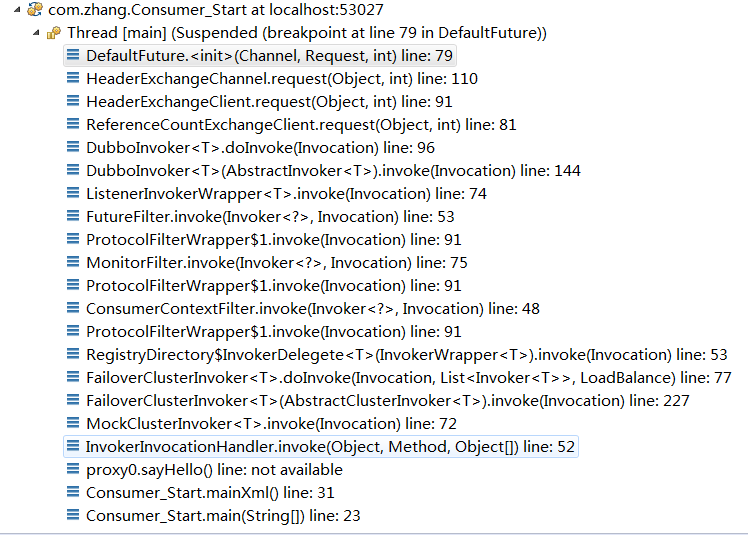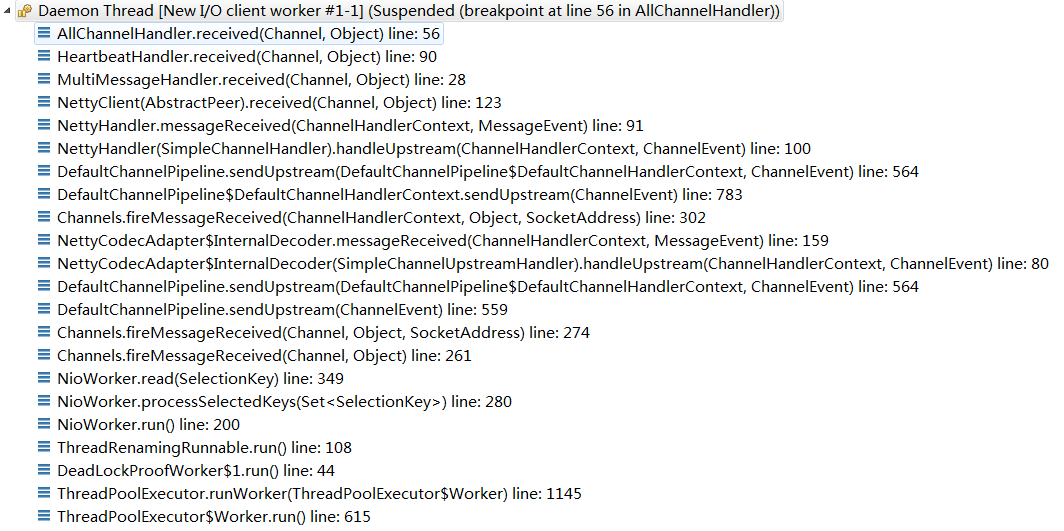一般情况,consumer发送请求时,创建一个DefaultFuture对象,然后阻塞并等待响应。DefaultFuture类,封装了请求和响应:
// 省略其他代码 public class DefaultFuture implements ResponseFuture { private final Lock lock = new ReentrantLock(); private final Condition done = lock.newCondition(); //waiting map private static final Map<Long, DefaultFuture> FUTURES = new ConcurrentHashMap<Long, DefaultFuture>(); private final Request request; private volatile Response response; }
1. consumer发送请求,阻塞等待响应。

调用代码:
HelloService helloService = (HelloService) appCtx.getBean("hello");
String hello = helloService.sayHello();
调用代理对象的sayHello方法,代理类proxy0由javassist动态生成,代码大致如下:
class com.alibaba.dubbo.common.bytecode.proxy0 implements com.alibaba.dubbo.rpc.service.EchoService, com.zhang.HelloService { public <init>(java.lang.reflect.InvocationHandler arg0){ handler=$1; } public static java.lang.reflect.Method[] methods; private java.lang.reflect.InvocationHandler handler; public java.lang.String sayHello(){ Object[] args = new Object[0]; //handler是InvokerInvocationHandler对象 Object ret = handler.invoke(this, methods[0], args); return (java.lang.String)ret; } public java.lang.Object $echo(java.lang.Object arg0){ Object[] args = new Object[1]; args[0] = ($w)$1; Object ret = handler.invoke(this, methods[1], args); return (java.lang.Object)ret; } }
进InvokerInvocationHandler
//InvokerInvocationHandler类 public Object invoke(Object proxy, Method method, Object[] args) throws Throwable { String methodName = method.getName(); Class<?>[] parameterTypes = method.getParameterTypes(); if (method.getDeclaringClass() == Object.class) { return method.invoke(invoker, args); } if ("toString".equals(methodName) && parameterTypes.length == 0) { return invoker.toString(); } if ("hashCode".equals(methodName) && parameterTypes.length == 0) { return invoker.hashCode(); } if ("equals".equals(methodName) && parameterTypes.length == 1) { return invoker.equals(args[0]); } //invoker是MockClusterInvoker return invoker.invoke(new RpcInvocation(method, args)).recreate(); }
跳过中间步骤,进到DubboInvoker的doInvoke方法,只分析一般的阻塞调用
protected Result doInvoke(final Invocation invocation) throws Throwable { RpcInvocation inv = (RpcInvocation) invocation; final String methodName = RpcUtils.getMethodName(invocation); inv.setAttachment(Constants.PATH_KEY, getUrl().getPath()); inv.setAttachment(Constants.VERSION_KEY, version); ExchangeClient currentClient; if (clients.length == 1) { currentClient = clients[0]; } else { currentClient = clients[index.getAndIncrement() % clients.length]; } try { boolean isAsync = RpcUtils.isAsync(getUrl(), invocation); boolean isOneway = RpcUtils.isOneway(getUrl(), invocation); int timeout = getUrl().getMethodParameter(methodName, Constants.TIMEOUT_KEY,Constants.DEFAULT_TIMEOUT); if (isOneway) { boolean isSent = getUrl().getMethodParameter(methodName, Constants.SENT_KEY, false); currentClient.send(inv, isSent); RpcContext.getContext().setFuture(null); return new RpcResult(); } else if (isAsync) { ResponseFuture future = currentClient.request(inv, timeout) ; RpcContext.getContext().setFuture(new FutureAdapter<Object>(future)); return new RpcResult(); } else {
//currentClient对象是 ReferenceCountExchangeClient/HeaderExchangeClient/HeaderExchangeChannel //拆分来看:ResponseFuture responseFuture = currentClient.request(inv, timeout); // responseFuture.get(); 调用get导致调用线程阻塞 RpcContext.getContext().setFuture(null); return (Result) currentClient.request(inv, timeout).get(); } } catch (TimeoutException e) { throw new RpcException(RpcException.TIMEOUT_EXCEPTION,
"Invoke remote method timeout. method: " + invocation.getMethodName() +
", provider: " + getUrl() + ", cause: " + e.getMessage(), e); } catch (RemotingException e) { throw new RpcException(RpcException.NETWORK_EXCEPTION, "Failed to invoke remote method: " +
invocation.getMethodName() + ", provider: " + getUrl() +
", cause: " + e.getMessage(), e); } }
进HeaderExchangeChannel
public ResponseFuture request(Object request, int timeout) throws RemotingException { if (closed) { throw new RemotingException(this.getLocalAddress(), null,
"Failed to send request " + request + ", cause: The channel " + this + " is closed!"); } // create request. Request req = new Request(); req.setVersion("2.0.0"); req.setTwoWay(true); req.setData(request); DefaultFuture future = new DefaultFuture(channel, req, timeout); try{ channel.send(req); }catch (RemotingException e) { future.cancel(); throw e; } return future; }
进DefaultFuture
public Object get() throws RemotingException { return get(timeout); } public Object get(int timeout) throws RemotingException { if (timeout <= 0) { timeout = Constants.DEFAULT_TIMEOUT; } if (! isDone()) { long start = System.currentTimeMillis(); lock.lock(); try { while (!isDone()) { //调用线程等待直到超时,或者被DubboClientHandler线程唤醒 done.await(timeout, TimeUnit.MILLISECONDS); if (isDone() || System.currentTimeMillis() - start > timeout) { break; } } } catch (InterruptedException e) { throw new RuntimeException(e); } finally { lock.unlock(); } if (! isDone()) { throw new TimeoutException(sent > 0, channel, getTimeoutMessage(false)); } } return returnFromResponse(); } private Object returnFromResponse() throws RemotingException { Response res = response; if (res == null) { throw new IllegalStateException("response cannot be null"); } if (res.getStatus() == Response.OK) { return res.getResult(); } if (res.getStatus() == Response.CLIENT_TIMEOUT || res.getStatus() == Response.SERVER_TIMEOUT) { throw new TimeoutException(res.getStatus() == Response.SERVER_TIMEOUT,
channel, res.getErrorMessage()); } throw new RemotingException(channel, res.getErrorMessage()); }
2. 在DubboClientHandler线程中,consumer接收响应,唤醒调用线程。

从ChannelEventRunnable进
//ChannelEventRunnable类 public void run() { //省略其他代码 switch (state) { case RECEIVED: handler.received(channel, message);break; default: logger.warn("unknown state: " + state + ", message is " + message); } }
进DecodeHandler
public void received(Channel channel, Object message) throws RemotingException { if (message instanceof Decodeable) { decode(message); } if (message instanceof Request) { decode(((Request)message).getData()); } if (message instanceof Response) { decode( ((Response)message).getResult()); } handler.received(channel, message); }
进HeaderExchangeHandler
public void received(Channel channel, Object message) throws RemotingException { channel.setAttribute(KEY_READ_TIMESTAMP, System.currentTimeMillis()); ExchangeChannel exchangeChannel = HeaderExchangeChannel.getOrAddChannel(channel); try { if (message instanceof Request) { // handle request. Request request = (Request) message; if (request.isEvent()) { handlerEvent(channel, request); } else { if (request.isTwoWay()) { Response response = handleRequest(exchangeChannel, request); channel.send(response); } else { handler.received(exchangeChannel, request.getData()); } } } else if (message instanceof Response) { handleResponse(channel, (Response) message); } else if (message instanceof String) { if (isClientSide(channel)) { Exception e = new Exception("Dubbo client can not supported string message: "
+ message + " in channel: " + channel + ", url: " + channel.getUrl()); logger.error(e.getMessage(), e); } else { String echo = handler.telnet(channel, (String) message); if (echo != null && echo.length() > 0) { channel.send(echo); } } } else { handler.received(exchangeChannel, message); } } finally { HeaderExchangeChannel.removeChannelIfDisconnected(channel); } } static void handleResponse(Channel channel, Response response) throws RemotingException { if (response != null && !response.isHeartbeat()) { DefaultFuture.received(channel, response); } }
进DefaultFuture
public static void received(Channel channel, Response response) { try { //收到响应删除future DefaultFuture future = FUTURES.remove(response.getId()); if (future != null) { future.doReceived(response); } else { logger.warn("The timeout response finally returned at " + (new SimpleDateFormat("yyyy-MM-dd HH:mm:ss.SSS").format(new Date())) + ", response " + response + (channel == null ? "" : ", channel: " + channel.getLocalAddress() + " -> " + channel.getRemoteAddress())); } } finally { CHANNELS.remove(response.getId()); } } private void doReceived(Response res) { lock.lock(); try { //给响应赋值 response = res; if (done != null) { //DubboClientHandler线程唤醒调用线程 done.signal(); } } finally { lock.unlock(); } if (callback != null) { invokeCallback(callback); } }
可以看到实际是两个线程在通信,main线程发送调用请求,并阻塞,DubboClientHandler线程接收到响应,并唤醒主线程。
DubboClientHandler是一个线程池,它执行工作队列中的任务(即ChannelEventRunnable对象)。
又是谁把ChannelEventRunnable对象放到DubboClientHandler线程池的工作队列中的呢?答案是New I/O client worker

//AllChannelHandler类 public void received(Channel channel, Object message) throws RemotingException { //DubboClientHandler线程池 ExecutorService cexecutor = getExecutorService(); try { cexecutor.execute(new ChannelEventRunnable(channel, handler, ChannelState.RECEIVED, message)); } catch (Throwable t) { throw new ExecutionException(message, channel, getClass() + " error when process received event .", t); } }
如果一个方法没有返回值,声明为:public void sayHello();
但配置不是oneway,那么cosumer还是会返回RpcResult,但是RpcResult中的内容为空。